二年级英语下册 Module 7 Unit 2(2)教案 外研版(一起)
二年级下册英语教案Unit7 Lesson2_先锋英语-经典教学教辅文档

Lesson 2教学内容:1. StructuresReview: What’s this? It’s a (dog).2. VocabularyReview: a dog, a cat, a rabbit, a fish, a bird, a lion, a tiger,a panda教具预备:1.单词卡片:dog, cat, rabbit, bird, fish, lion, tiger, panda.2.有以上动物图片的旧杂志。
3.布偶Uncle Booky.4.着色用的彩笔或蜡笔。
教学过程:1. Warm-up(1)将动物的卡片随意贴在教室周围。
(2)教师说:“Dog.”用一样的步骤练习本单元其他的动物。
2. Preview(1) 举起单词卡片rabbit并模仿兔子的动作,例如,原地跳并加上面部表情,让先生也模仿兔子的动作。
举起单词卡片dog,模仿狗的动作,汪汪叫或模仿狗喘气,让先生模仿。
(2) 反复以上步骤复习单词cat, bird, lion, tiger, panda, 并做动作(举起不同的卡片,让先生做动作)。
(3)让单个先生说出动物的名称,全班先生听并模仿;3.Listenandguess;先生用书第4页;(1)告诉先生接下去玩一个猜谜游戏.活动中他们将;断是哪些动物;(2)播放第一个动物的叫声,发问:“What’s;tiger.”;(3)反复以上步骤,完成对录音中其他动物叫声的听;4. Listen and point先生用书第4页(1) 拿出本单元的教学卡片,贴在黑板上一切先生都能看见的地方。
依次指每一个卡片,引导先生说出动物的名称。
(2) 说:“Point to the bird, please.”让先生指向小鸟的教学卡片。
用一样的方法完成其他几张卡片。
(3) 让先生翻开书第4页,看页面左侧的插图。
告诉先生接下去听录音,指相应的插图。
(4) 播放第一句录音内容,让先生找到相应的动物指出来。
二年级下英语教学设计-Module7Unit2 We’re having a picnic.-外研社

二年级下英语教学设计-Module7Unit2 We’re having apicnic.-外研社(一起)一、教学目标本节课学生将学会运用一些英语语言知识描述野餐的过程,可以用英语表达自己的意见和分享自己的经历。
二、教学重点和难点教学重点:运用语言知识描述野餐的过程和场景。
教学难点:如何在语境中理解一些常用的语言表达习惯,如英语中常用的单复数概念,用英语描述简单的场景和人物。
三、教学材料外研社(一起)二年级下英语教材Module7Unit2 We’re having a picnic.四、教学步骤Step 1 Warm-up1.Greetings: 与学生互相问候。
2.Review: 复习上一节课的内容——在公园玩耍。
通过一些问题的提问,巩固学生在描述人物、场景等方面的能力,如“Who can we see in the park? What are they doing in the park?”Step 2 Presentation1.Lead-in: 小组呈现野餐的图片,学生观看后,学习相关的单词和短语,如basket, bread, cheese, juice, sandwich, apple, orange等等。
2.Listening: 向学生播放有关野餐的录音,让学生听懂对话,并能表达对话的内容。
3.Speaking: 学生们模仿录音中的对话,欣赏并讨论录音中提到的食物和饮料,并谈论哪些是他们最喜欢的野餐食品。
Step 3 Practice1.Role-play:将学生分成两个小组,让他们进行野餐的对话,模拟野餐时的会话和表达方式。
2.Writing:练习学生的表达能力,让他们尝试写一篇野餐的小故事,描述自己的野餐经历,激发学生的创造力和表达能力。
Step 4 Production1.Show your picnic:让学生在课前准备一些野餐食品和饮料,并在课堂上展示给大家欣赏。
2.Survey:学生进行调查,询问身边同学或家人最喜欢的野餐食品,并说出理由。
二年级英语下册 Module7Unit2(1)教案 外研(一起)

外研版(一起)二年级英语下册教案Module Seven unit 2【热身和导入】1. Say the poem from module 5: We are playing on the playground.2. Talk about your pictures.承接第一课时的作业,请有照片的同学到前面介绍照片。
.3 Look and say.用PPT自制课件依次出示第一单元中,Sam is saying a poem. Daming is doing a play.等五张图片,并What is he/ she (are they) doing 提问,引导学生用 He/ She is…或They are…回答。
【任务呈现】1. Introduce Tingting.承接上一活动中的最后一幅图,出示Tingting is drawing.的图片。
然后介绍并提问:This is Tingting. What is she doing? 在学生回答She is drawing.后,再问:Where is she drawing? Let’s look and listen to the story.【任务准备】plete Activity One.① Listen to the story and get some individual students to answer the question.② Show students the questions in Activity 2 one by one. Ask them to read and write down the answers on the book.用课件依次出示教材活动2中的问题,可以通过翻译检查学生对问题的理解。
然后,请学生自读并回答教材中的问题。
③ Ask them to compare your answers with their partners, then answer the questions one by one.④ Listen and repeat.2. Complete Activity Three.① Introduce the song. “You see Thingting is very happy. Because today is Children’s Day. Now let’s listen to a song about Children’s Day.”Play the cassette and ask to listen to the song.② Ask some students to read the words. And add some simple actions when necessary.③ Listen , try to follow and do the actions.④ Listen again and sing together.【任务完成】1. Complete Activity Four.①“On children’s Day, the children will visit the zoo, too. Let’s go to the zoo and have a look what the animals are doing? What animals can you find?”② Discuss with your partner what they are doing.③ Show students the pictures one by one and ask them to answer the questions. “What are the…doing?”④ A guessing game. The teacher will say what the animals are doing, then ask the students to tell the animals’ names.T: They are sleeping. What are they? S.s: They are giraffes.After the model, ask them to do in pairs.【家庭作业】1. Complete Activity One on page 28 of Activity Book.。
外研二下Module 7 Unit 2 We’re having a picnic.教学设计
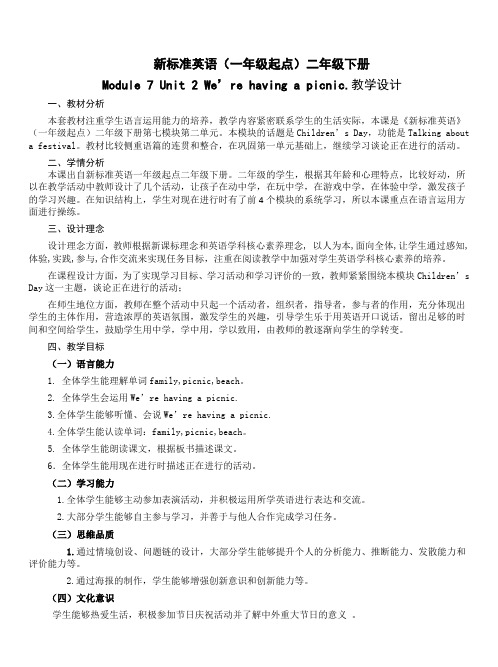
新标准英语(一年级起点)二年级下册Module 7 Unit 2 We’re having a picnic.教学设计一、教材分析本套教材注重学生语言运用能力的培养,教学内容紧密联系学生的生活实际,本课是《新标准英语》(一年级起点)二年级下册第七模块第二单元。
本模块的话题是Children’s Day,功能是Talking about a festival。
教材比较侧重语篇的连贯和整合,在巩固第一单元基础上,继续学习谈论正在进行的活动。
二、学情分析本课出自新标准英语一年级起点二年级下册。
二年级的学生,根据其年龄和心理特点,比较好动,所以在教学活动中教师设计了几个活动,让孩子在动中学,在玩中学,在游戏中学,在体验中学,激发孩子的学习兴趣。
在知识结构上,学生对现在进行时有了前4个模块的系统学习,所以本课重点在语言运用方面进行操练。
三、设计理念设计理念方面,教师根据新课标理念和英语学科核心素养理念, 以人为本,面向全体,让学生通过感知,体验,实践,参与,合作交流来实现任务目标,注重在阅读教学中加强对学生英语学科核心素养的培养。
在课程设计方面,为了实现学习目标、学习活动和学习评价的一致,教师紧紧围绕本模块Children’s Day这一主题,谈论正在进行的活动;在师生地位方面,教师在整个活动中只起一个活动者,组织者,指导者,参与者的作用,充分体现出学生的主体作用,营造浓厚的英语氛围,激发学生的兴趣,引导学生乐于用英语开口说话,留出足够的时间和空间给学生,鼓励学生用中学,学中用,学以致用,由教师的教逐渐向学生的学转变。
四、教学目标(一)语言能力1. 全体学生能理解单词family,picnic,beach。
2. 全体学生会运用We’re having a picnic.3.全体学生能够听懂、会说We’re having a picnic.4.全体学生能认读单词:family,picnic,beach。
5. 全体学生能朗读课文,根据板书描述课文。
外研版(一起)二年级英语下册教案Module 7 Unit 2 We're having a picnic.教案3

Module 7 Unit 2 We're having a picnic.教学设计一、教学目标1.Can read and remember the vocabulary.2.Be able to make sentences according to the pictures.3.Read and recite the text.二、教学重难点1.V ocabulary: flying a kite, sleeping, having a picnic2.Pattern: We’re having a picnic.My father is flying a kite.三、教学工具Radio、cards、VCD、tapes四、教学过程Step 1 Warming up1.Free talk between the teacher and the students.2.Sing a song.“I am listening to music.”3.Say and do some actions.Step 2 Presentation and practice1.T alk about the picture of the text and introduce Tingting’s family then teach the new word “sleeping”.2.Listen to the CD-ROM then answer the question “Where are they?”3.Look at the picture of the text and ask “What is the weather like?”4.Listen to the CD-ROM then answer the question “What is Tingting’s family doing?” then teach the new word “picnic”.5.If the children were Tingting, describe the picture.Eg: My name is Tingting. I am at the park with my family. We’re having a picnic.6.Listen and match “What is everyone doing?” and check the answers.7.Listen and repeat the text.8.Game : There are some questions in the boxes. Students answer the questions can get some stars for their groups.9.Do some writen exercises on activity books and checkStep 3 Consolidation and extension1. Show a picture about Sam’s family, and the students discuss it in group, then introduce what is Sam’s family doing.2. Show a picture about Sam’s friends, and the students discuss it in group, then introduce wha t are Sam’s friends doing.3. Show a picture about some animals , then ask and answer in pairs.Eg: A:What are the lions doing? B:They’re eating.Step 4 SummaryGuide the students to recall what they learnt in this class, and emphasize the words with –ing.五、作业1. Read the dialogue and the sentence .2. Listen to the text for 3 times.3. Draw a picture about“Happy Weekend” and then talk about it.。
二年级下英语【教学设计】-Module7Unit2 We’re having a picnic.-外

二年级下英语教学设计-Module7 Unit2 We’re having a picnic.知识目标1.掌握 picnic、sandwich、juice、cake、fruit 这些单词的读音和意思,并能正确拼写。
2.能够理解和使用句型“Are you having ______?”和“ Yes, I am. / No, I’m not.”。
3.能够合理运用所学单词和句型描述野餐活动。
能力目标1.提高学生听、说、读、写的基本技能。
2.培养学生的合作意识和团队合作能力。
3.激发学生参与英语交流的兴趣和自信心。
教学重点学生掌握所学单词和句型,能够用英语描述野餐的活动内容。
教学难点学生能够自主组织语言描述野餐活动,提高英语交流的自信心和能力。
教学准备1.PPT2.野餐布、食物模型(三明治、水果、蛋糕、果汁等)3.学生课前预习资料教学过程Step 1 思维导入(5分钟)1.通过PPT向学生展示一张野餐的图片,创设情境,引出本课主题。
2.师生对话:老师问学生“Have you ever had a picnic before?” ,引导学生回答。
同时,出示单词picnic的拼写和发音。
Step 2 课堂讲授(30分钟)1.向学生介绍本课的目标和重点,并引出所需单词和句型。
2.利用食物模型进行单词教学。
出示三明治(sandwich)、水果(fruit)、蛋糕(cake)、果汁(juice)四个单词,并对其发音进行学生模仿。
并用图片向学生展示相关各单词的图片。
3.利用PPT和野餐布表演小品,模拟野餐活动。
同时出示所需句型“Are you having ______?”和“ Yes, I am. / No, I’m not.”,引导学生熟悉该句型的用法。
4.对比练习。
老师出示一幅图片并问“Are you having a sandwich?”,学生进行回答并进行练习(Yes, I am. / No, I’m not.)。
二年级英语下册 Module 7 Unit 2(2)教案 外研版(一起)
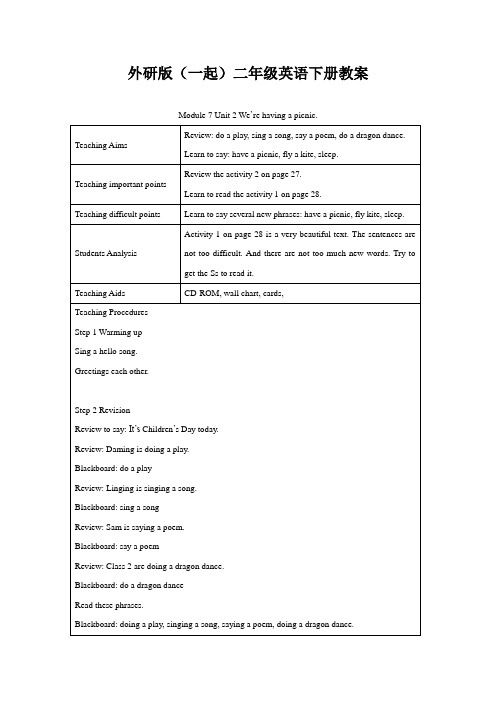
Blackboard: do a dragon dance
Read these phrases.
Blackboard: doing a play, singing a song, saying a poem, doing a dragon dance.
Teaching important points
Review the activity 2 on page 27.
Learn to read the activity 1 on page 28.
Teaching difficult points
Learn to say several new phrases: have a picnic, fly kite, sleep.
Review to say: Daming is doing a play with some children. Lingling is singing a song. Sam is saying a poem. The children from Class 2 are doing a dragon dance.
Students Analysis
Activity 1 on page 28 is a very beautiful text. The sentences are not too difficult. And there are not too much new words. Try to get the Ss to read it.
Read: page 2 activity 3: Describe the Children’s Day.
二年级下英语教学设计-Module7Unit2We’rehavingapicnic.-外研社(一起)

二年级下英语教学设计Module7Unit2 We’re having a picnic.外研社(一起)教学目标本节课旨在让学生能够理解和运用一般现在进行时态描述正在进行的动作,同时掌握与野餐相关的词汇和句型。
学生能够通过本节课的学习,提高英语听说能力,增强语言实践能力,培养合作意识。
教学内容1. 词汇:学习与野餐相关的词汇,如:picnic, sandwich, cake, fruit, drink等。
2. 句型:学习并运用一般现在进行时态描述正在进行的动作,如:We're having a picnic. He's eating a sandwich. She's drinkinga drink.3. 功能:能够运用所学句型和词汇描述野餐场景,进行简单的交流。
教学重点与难点1. 教学重点:掌握一般现在进行时态的构成和用法,能够用所学句型和词汇描述野餐场景。
2. 教学难点:正确运用一般现在进行时态描述正在进行的动作,如:We're having a picnic. He's eating a sandwich.教具与学具准备1. 教具:PPT课件,野餐场景图片,单词卡片,句型卡片。
2. 学具:学生自备野餐食物,用于角色扮演。
教学过程1. 导入:通过展示野餐场景图片,引导学生谈论野餐的相关话题,激发学生学习兴趣。
2. 新课内容展示:利用PPT课件,呈现野餐场景,教授与野餐相关的词汇和句型。
3. 课堂互动:组织学生进行角色扮演,模拟野餐场景,运用所学句型和词汇进行交流。
4. 巩固练习:通过游戏、竞赛等形式,巩固所学词汇和句型。
板书设计1. 课题:Module7Unit2 We’re having a picnic.2. 词汇:picnic, sandwich, cake, fruit, drink等。
3. 句型:We're having a picnic. He's eating a sandwich. She's drinking a drink.作业设计1. 家庭作业:完成课后练习题,巩固所学知识。
外研版小学英语(新标准一起)二年级下册全册教案
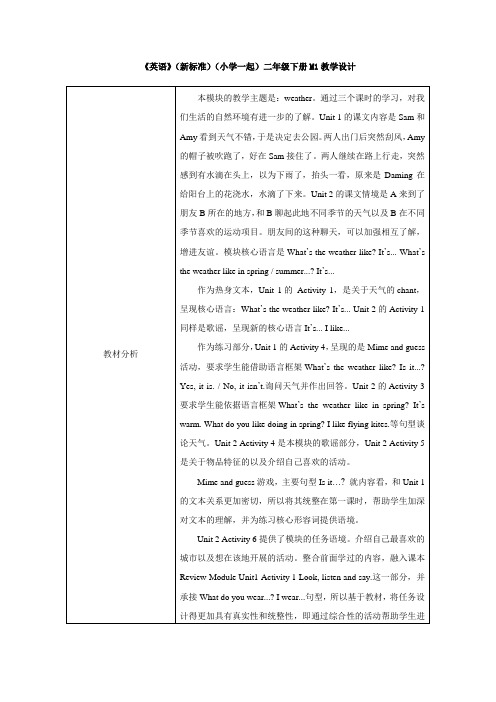
《英语》(新标准)(小学一起)二年级下册M1教学设计2. 全班学生能朗读文本,听说认读:What do you like doing in summer / winter? I like... v+ing. 大多数学生能在情景表演中描述不同季节喜欢的运动,完成Page 6 Activity 3。
技能目标:1. 全班学生能理解对话文本,看图描述对话。
2. 大多数学生能在图片提示和老师的帮助下进行小组活动,描述不同天气和不同的活动。
3. 大多数学生能感知绘本内容和情感,通过小组活动,回顾绘本进行填空练习,培养合作与探究的能力。
情感目标:学生能够通过不同天气,感受到天气对人们生活带来的影响。
通过绘本阅读,感受生活的多姿多态,培养热爱生活的情感。
教学重点与难点教学重点:词汇skiing的音、义、形。
词汇snows的发音。
对不同天气喜欢活动的描述。
教学难点:简单表达自己在不同季节喜欢的活动。
教学辅助PPT课件、CD-ROM、学生练习纸教学策略借助图片或关键词,复述文本;通过活动用书的听力练习和绘本阅读,描述不同天气喜欢的活动,分层次练习、巩固核心语言点,强化文本内容。
教学内容(含时间设置)教学活动设计意图教师活动学生活动Step 1: Pre-task preparation(5 minutes) 1. Free talk:T: What’s theweather like today?T: Let’s review achant.2. Listen and say a1. Review Unit 1and chant last term.2. Enjoy a chant通过思维导图激活学生第一课时的思维图示,借助chant调动学生的思维,引导学生说出打篮球、踢足球、跑步等,为后面的学习做4. Let the students fill in the blanks of the text.5. Retell the story with the help of the mind map. 4.Fill in the blankson the PPT.5. Retell the textaccording to thekey words on thePPT.借助句型框架,分析整理相关文本信息,尝试表达中推进语言的习得情况。
Module7Unit2We'rehavingapicnic(课件)(一起)英语二年级下册
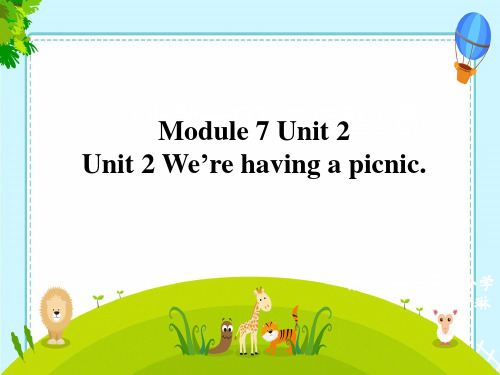
Let’s ask.
They’re having a picnic at the beach.
What is Fangfang's mother doing
She's eating.
Let’s ask.
They’re having a picnic at the beach.
They are playing at the beach.
She is jumping.
We’re running.
We are playing catch.
We’re very happy.
The weather is warm. We’re at the park. We’re having a picnic.
Let’s read.
Bunny
My mother is working. 1
My father is making a cake. 2
My sister is singing a song. 3
My brother is drawing a picture. 4
The weather is sunny and warm. We’re having a picnic. We’re all eating.
(小M学od一u起le )7 U二n年it 2级下册 Unit 2 We’re having a picnic.
青岛平安路第二小学 丁琳
Good morning, boys and girls. It's ___ today. I’m__from___. Daming/Lingling/ Sam/Amy is______.Some children are _______.
外研版(一起)二年级英语下册教案教案Module 7 Unit 2 教案

Module 7Unit 2 We’re having a picnic.教学模式介绍探究式教学模式是指在教学过程中,要求学生在教师指导下,通过以“自主、探究、合作”为特征的学习方式对当前教学内容中的主要知识点进行自主学习、深入探究并进行小组合作交流,从而较好地达到课程标准中关于认知目标与情感目标要求的一种教学模式。
其中认知目标涉及与学科相关知识、概念、原理与能力的掌握;情感目标则涉及思想感情与道德品质的培养。
探究式课堂教学模式的教学环节:创设情境——启发思考——自主(或小组)探究——协作交流——总结提高设计思路说明【创设情境】本课时以口语交际为主要形式展开教学,本模块的话题是培养学生能运用现在进行时表达某人正在做某事。
让学生在日常生活中能运用所学语言,能听懂会说能听懂,会说句型My father is eating. We’re having a picnic..【启发思考】结合学生所感兴趣的野餐来展开对话,采用对话分解的方法,循序渐进,由简单到繁杂,并对重点句型进行强化训练,很好地巩固了重点句型,并让学生对句型灵活运用有了一定的掌握。
【自主或小组探究】通过对某人正在做某事的介绍的情景让学生感知对话的内容,根据实际情况,在设定的情境中介绍现在进行时进行训练。
【协作交流】学生只有经过了认真的自主探究,积极思考后,才可能进入高质量的协作交流阶段。
通过分角色对话操练重点句型,把所学运用到实际情景中。
【总结提高】通过学习自主完成对话,教师引导学生对问题进行归纳总结,进一步对语法知识进行深化提高,对学生成果进行分析、归纳、迁移、提高。
学生通过完成任务将学到的知识形成的技能转化成在真实生活中运用英语的能力。
教材分析本节课是《新标准英语》一年级起点第四册第七模块第二单元We’re having a picnic,是一篇新授课。
主要内容是现在进行时时形式的表达用语。
引导学生乐于通过实际情景介绍,积极尝试使用英语。
二年级下册英语教案-Module 7 Unit 2-外研社(一起)

二年级下册英语教案-Module 7 Unit 2-外研社(一起)教学目标1.学生能够听、说、读、写生词和短语“would you like some…”,“Yes, please.”,“No, thanks.”;2.学生能够在实际生活中运用所学句型,礼貌地提出请求或拒绝;3.学生能够根据所听内容正确判断并勾画物品的形状。
教学重点1.生词和短语的学习和掌握;2.“would you like some…”、“Yes, please.”、“No, thanks.” 句型的学习和实际运用。
教学难点学生能够根据所听的内容绘制相应物品的形状。
教学准备1.多媒体课件;2.学生用品:彩笔、铅笔、橡皮等。
教学过程Step 1:热身1.教师问:What would you like to drink/eat?。
引导学生回答:I’d like some milk/bread, please.教师可通过学生的回答略加评价,如:You’re right! Very good!等。
Step 2:学习新知1.教师运用多媒体课件,呈现生词和短语:“would you like some…”;“Yes, please.”;“No, thanks.”;并解释其含义和用法。
2.教师运用多媒体课件和物品图片或实物,模拟对话:“Would you like some tea?” “Yes, please.” “Would you like some bread?” “No, thanks.” 并引导学生模仿,反复进行两两练习,培养学生的对话练习能力。
Step 3:模仿练习1.教师运用多媒体课件,呈现图片,提问学生:What shape is it?并引导学生根据图片,用彩笔或铅笔勾画物品形状。
同时,教师对学生进行语言指导,如:It’s a square/circle/rectangle.。
Step 4:拓展应用1.教师出示一些图片,引导学生向同伴提出请求,“Would you like some…?”并根据对方的回答说出相应的礼貌用语:“Yes, please.”或“No, thanks.”,鼓励学生勇于表达和互动。
二年级下英语教学设计-Module7Unit2 We’re having a picnic._外研社(一起)

Module 7 Unit 2 We’re having a picnic.一、教材分析本节课是二年级起点第四册英语Module 7 Unit 2的课文教学,课型为巩固课。
学生在前几个模块的学习中对现在进行时和动词短语的用法有了一定的了解,在本模块中第一单元我们已经通过看图片学习描述了儿童节的活动。
因而在第一单元的基础之上来学习本模块的第二单元。
通过不同形式的活动交流,进一步学习用进行时来描述野餐活动。
二、学生分析小学二年级学生有一定的英语基础,并通过前几个模块的学习对进行时时态的用法有所掌握,有利于理解本节课句式的含义。
但本课文本中的个别语句较长,所以学生学习起来难度较大,因此在学习与操练过程中,我将注意创设良好情境,通过更多真实的情境培养学生听说能力,帮助他们理解掌握这一部分的知识,体验成功,最大限度地满足不同层次学生的需要。
三、教学目标1、Knowledge Aim(知识目标)全体学生能够理解和运用单词:picnic family beach全体学生能够理解和运用单词句子: We’re having a picnic.My father\mother is …能够描述野餐活动。
2、Ability Aim(能力目标)培养学生通过听、说、读,能够结合现实生活正确的利用现在进行时来谈论正在进行的活动。
3、Moral Aim(情感目标)乐于运用英语描述正在进行的活动,体验学习的快乐。
四、教学重点(Main Points )Words:picnic family beachDrills: We’re having a picnic.五、教学难点(Difficult Points )1.如何正确运用现在进行时来描述正在进行的活动。
六、教学过程(Teaching procedure )Step ⅠPreparation1.WarmerChant M7U12. RevisionLook the pictures and answerIt’s Children’s Day today.What are they doing?设计意图:通过chant 创设轻松的学习氛围。
Module 7(教学设计)外研版(一起)英语二年级下册

Module 7(教学设计)外研版(一起)英语二年级下册教学目标本节课主要通过让学生认识不同颜色、形状的魔方,能够听懂并运用描述魔方的单词和短语,能够运用句型“Can you see…?” 询问别人魔方上的颜色和形状,并且会用所学语言描述自己喜欢的魔方颜色和形状。
教学重点1.让学生能够听懂并运用描述魔方的单词和短语。
2.通过句型“Can you see…?” 询问别人魔方上的颜色和形状,并且回答问题。
教学准备1.多个不同颜色、形状的魔方。
2.课堂图片和Flash进行展示和教学素材。
教学过程Step 1. Warm-up(5 minutes)1.让学生喊出自己喜欢的颜色和形状,强化学生对颜色和形状的认识。
2.谈论喜欢的玩具,引入魔方的话题。
Step 2. Presentation(15 minutes)1.展示魔方,让学生看到不同颜色和形状的魔方,使学生对魔方有直观认识。
2.通过图片和Flash展示魔方,并教授魔方的单词和短语。
3.介绍句型“Can you see…?”,告诉学生如何用这个句型去询问别人魔方上的颜色和形状。
4.通过板书和课堂演示训练学生听懂和运用所学语言。
Step 3. Practice(15 minutes)1.让学生在小组内练习用所学语言描述自己喜欢的魔方颜色和形状,并配合问答句型“Can you see…?”进行练习。
2.在小组练习中,教师可以在学生练习过程中帮助纠正语言错误。
Step 4. Production(10 minutes)1.演示一组表演成果,让学生展示出学习的内容和所学语言。
2.支持学生敢于表演,并鼓励他们用所学语言进行交流。
Step 5. Review(5 minutes)1.通过操练和学生互相交流,总结学生在课堂中学到的语言和所学魔方颜色的单词和短语。
2.确保学生掌握所学知识,对于掌握不好的学生,应该给予及时指导。
总结回顾本节课主要让学生认识不同颜色和形状的魔方,学习魔方相关的单词和短语,并用“Can you see…?”句型进行交流。
小学二年级英语下册全册教案(外研版)
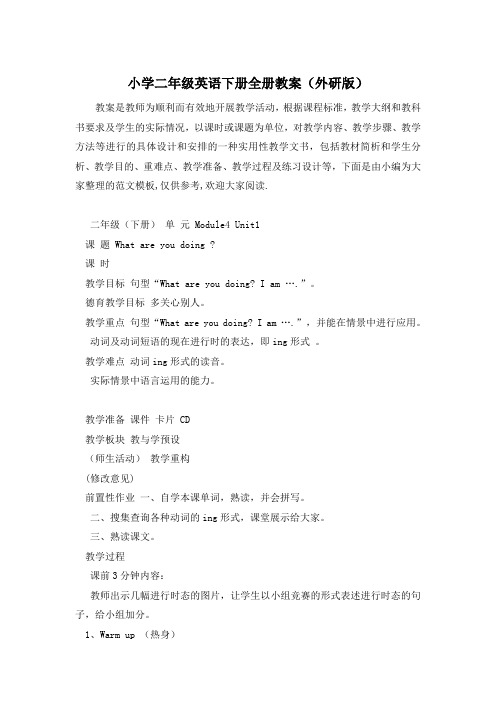
小学二年级英语下册全册教案(外研版)教案是教师为顺利而有效地开展教学活动,根据课程标准,教学大纲和教科书要求及学生的实际情况,以课时或课题为单位,对教学内容、教学步骤、教学方法等进行的具体设计和安排的一种实用性教学文书,包括教材简析和学生分析、教学目的、重难点、教学准备、教学过程及练习设计等,下面是由小编为大家整理的范文模板,仅供参考,欢迎大家阅读.二年级(下册)单元 Module4 Unit1课题 What are you doing ?课时教学目标句型“Wh at are you doing? I am ….”。
德育教学目标多关心别人。
教学重点句型“What are you doing? I am ….”,并能在情景中进行应用。
动词及动词短语的现在进行时的表达,即ing形式。
教学难点动词ing形式的读音。
实际情景中语言运用的能力。
教学准备课件卡片 CD教学板块教与学预设(师生活动)教学重构(修改意见)前置性作业一、自学本课单词,熟读,并会拼写。
二、搜集查询各种动词的ing形式,课堂展示给大家。
三、熟读课文。
教学过程课前3分钟内容:教师出示几幅进行时态的图片,让学生以小组竞赛的形式表述进行时态的句子,给小组加分。
1、Warm up (热身)活动一:歌曲演唱教学参考时间:1—2分钟教师播放歌曲What Are You Doing?的录音,师生共同演唱。
活动二:口语练习教学参考时间:1-- 2分钟教师就学生所学过的内容,尤其是新学内容进行日常交际,目的在于运用语言。
可以是学生自我介绍,也可以是学生间对话练习。
如:A: My English name is …. What’s your English name?B: M y English name is …. How do you do?A: How do you do? Where are you from?B: Australia.A: What are you doing?B: I’m waiting for my mom.A: Nice to meet you. Good-bye.B: Bye.2、Review (复习)活动三:词汇复习教学参考时间:4—5 分钟教师出示第一课时所学动词短语的图片,找能力好的学生认读,其他同学跟读。
外研版英语二年级下册《Module7Unit2We'rehavingapicnic》教案
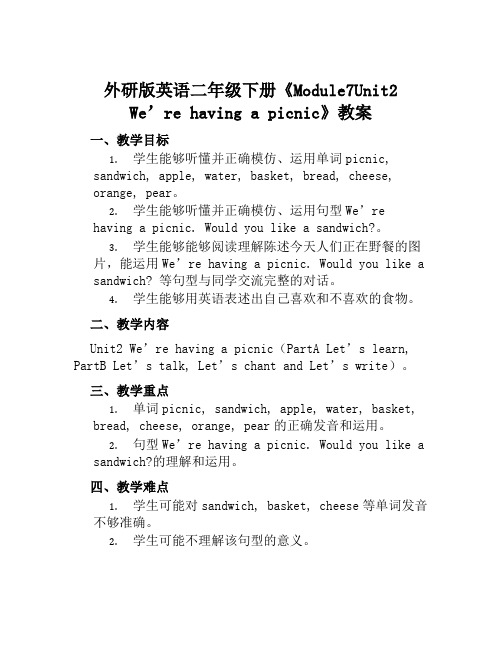
外研版英语二年级下册《Module7Unit2 We’re having a picnic》教案一、教学目标1.学生能够听懂并正确模仿、运用单词picnic,sandwich, apple, water, basket, bread, cheese,orange, pear。
2.学生能够听懂并正确模仿、运用句型We’rehaving a picnic. Would you like a sandwich?。
3.学生能够能够阅读理解陈述今天人们正在野餐的图片,能运用We’re having a picnic. Would you like a sandwich? 等句型与同学交流完整的对话。
4.学生能够用英语表述出自己喜欢和不喜欢的食物。
二、教学内容Unit2 We’re having a picnic(PartA Let’s learn, PartB Let’s talk, Let’s chant and Let’s write)。
三、教学重点1.单词picnic, sandwich, apple, water, basket,bread, cheese, orange, pear的正确发音和运用。
2.句型We’re having a picnic. Would you like asandwich?的理解和运用。
四、教学难点1.学生可能对sandwich, basket, cheese等单词发音不够准确。
2.学生可能不理解该句型的意义。
五、教学方法听力训练、情境训练、问答互动、小组合作。
六、教学过程Step1:Class opening1.Greet the students and start class.2.Sing a song about food and ask students if they like the food in the song.Step2:Let’s learn1.Teach students the new words, including picnic, sandwich, apple, water, basket, bread, cheese, orange, pear.2.Demonstrate the correct pronunciation of each word and have students repeat after you.3.Show students pictures of the new words, and have them repeat the words agn.e the words in a sentence and ask students to repeat it.Step3:Let’s talk1.Show students a picture of people having a picnic.2.Ask students what the people are doing.3.Ask students if t hey think it’s fun to havea picnic, and why.e the sentence。
外研版(一起)二年级英语下册教案Module 7 Unit 2 We're having a picnic.教案2

Module 7Unit 2 We're having a picnic.教案2一、教学目标(一)知识技能目标:能正确地听、说下列句型:We’re having a picnic.My father is flying a kite.(二)运用能力目标:1.要求学生能描述正在进行的活动。
2.能够熟练说唱本单元的童谣歌曲。
(三)素质教育目标:让学生感受英语课堂的活跃性,让学生在日常生活中能运用所学语言。
二、教学重点熟练掌握下列句子:We’re having a picnic.My father is flying a kite.三、教学难点1.具体描述图片中进行的不同活动,扩大语言的交际面。
2.熟练掌握本单元的重点句子。
四、教学意图1.增加已学知识的复现率,培养学生对重点词汇和句子的认读能力。
2.通过多种形式的活动激发学生的学习兴趣。
3.培养学生的自主学习能力。
五、教具准备1.教材相配套的教学录音带。
2.教学挂图。
3.一些小奖品。
六、教学过程Step 1 GreetingsStep 2 Free talkStep 3 Warmer1. Sing “I’M LISTENING TO MUSIC”2. Let’s chant.It’s hot. It’s cold.It's hot. It’s cold.And it's raining, too.It’s sunny and it’s windy.We don’t know what to do.It’s hot. It’s cold.It’s hot. It’s cold.And it's raining, too.It’s sunny and it’s windy.Is this weather true?Step 4 Presentation and practice.1. Picture talkingShow some pictures on the screen.T: What’s he doing?S1: He is …T: What’s she doing?S2: She is …(Reading books, dancing, playing basketball, drawing a picture, singing) T: Look! What’s Mr Liu doing?S3: You are drawing a picture.T: Great! I am drawing a picture. Guess! What am I drawing?Ss: A kite.T: Look! He is flying a kite.Teach the word ‘fly’Read:fly—flying—flying a kite2. Introduce the members of Tingting’s family.T: I like drawing. Do you like drawing? Today, I’ll introduce a friend to you. She likes drawing, too. Her name is Tingting. Tingting has a happy family. Look! This is her father. This is her mother. And this is her grandma. This is Tingting’s family. Tingting loves her family. Do you love your family?T: Every people has father and mother. Do you love your father and mo ther? Let’s say “I love you.”Father + mother + I love you= family.T: Look!Tingting is at the park with her family. What are they doing?Ss: They are having a picnic.T: Great! Tingting says “We are having a picnic.”Read:Picnic --- have a picnic ----having a picnic---- We are having a picnic.T: Look! They are children from class 6. What are they doing?S3: They are having a picnic.T: Tingting’s families are having a picnic. Do you want to have a picnic?Now let’s go.2. Listen and answer.(1) What’s Tingting’s father doing?He is flying a kite.(2) What’s Tingting’s mother doing?She is eating.(3) What’s Tingting’s grandma doing?She is sleeping.(4) What’s Tingting doing?Tingting is drawing a picture.(5) What’s the weather like?It is sunny and warm.(6) What’s the family doing?They are having a picnic.3. Let’s sing.? “I am listening to music.” “It’s Children’s Day.”4. Listen and repeat.a. Read after CD sentence by sentence.b. Read after the little teacher.c. Read together.Step 5 Consolidation1. Let’s act and say.The teacher invites several students to come to the front to mine some actions. The other students should guess what is he \ she doing.S4: (mine reading books)S5: She\ He is reading books.S5: (mine watching TV)S6: He \ She is watching TV.2. Let’s choose the phrases, act and answer.The teacher invites some pairs of students to come to the front.The sthdents can choose a phrase from the teacher and mine the action. The other students and the teacher ask them “What are you doing?” They should answer “ We are ……”S7&S8:(mine playing football.)T&Ss: What are you doing?S7&S8: We are……T: What are they doing?S8: They are playing football.3. Picture talking.T: What are they doing?S8: They are ……Let’s talk.4. The teacher asks the students to draw a picture about the picnic with their families. Then they can talk about the picture in front.T: I like drawing. Look! I’m at the park with m y family. We are having a picnic. My father is flying a kite. My mother is eating. And my sister is sleeping. I am drawing a picture. The weather is good. It’s sunny and warm. We are very happy.五、HomeworkDraw a picture about Children’s Day. And talk ab out it with your friends in English.。
二年级英语下册 Module 7 Unit 1(2)教案 外研版(一起)
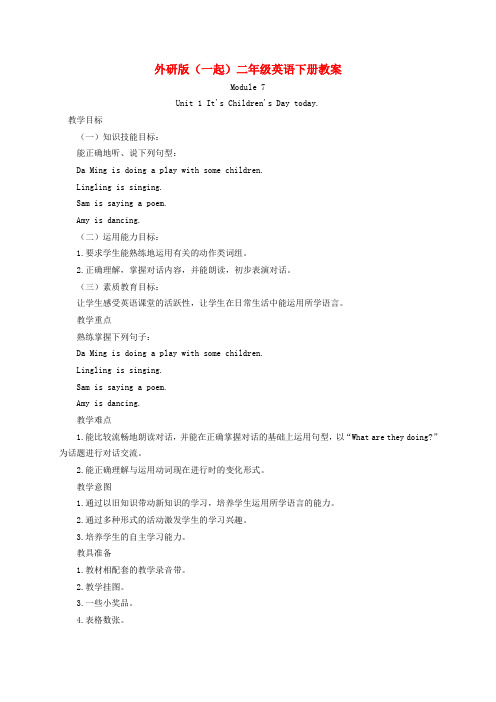
外研版(一起)二年级英语下册教案Module 7Unit 1 It's Children's Day today.教学目标(一)知识技能目标:能正确地听、说下列句型:Da Ming is doing a play with some children.Lingling is singing.Sam is saying a poem.Amy is dancing.(二)运用能力目标:1.要求学生能熟练地运用有关的动作类词组。
2.正确理解,掌握对话内容,并能朗读,初步表演对话。
(三)素质教育目标:让学生感受英语课堂的活跃性,让学生在日常生活中能运用所学语言。
教学重点熟练掌握下列句子:Da Ming is doing a play with some children.Lingling is singing.Sam is saying a poem.Amy is dancing.教学难点1.能比较流畅地朗读对话,并能在正确掌握对话的基础上运用句型,以“What are they doing?”为话题进行对话交流。
2.能正确理解与运用动词现在进行时的变化形式。
教学意图1.通过以旧知识带动新知识的学习,培养学生运用所学语言的能力。
2.通过多种形式的活动激发学生的学习兴趣。
3.培养学生的自主学习能力。
教具准备1.教材相配套的教学录音带。
2.教学挂图。
3.一些小奖品。
4.表格数张。
教学过程Step 1 Warming-up教师带学生一起做游戏“大头照连连看”。
请七位同学到讲台上来,其他同学都是“照相机”。
把这七位同学按照顺序编上号,然后按照顺序请在讲台上的几位同学一个连一个地做出各种自己喜欢的姿势,教师带领其他学生发号施令:“Number one ,go!”然后1号同学就说出自己正在做的姿势,如“I am dancing .”而后其他六位同学也逐一说出自己的动作。
最后由各位充当“照相机”的学生评选出“最佳上镜奖”、“最有创意姿势奖”等,老师将给予这些同学奖励。
外研版二年级英语下册Module7Unit2We’rehavingapicnic教案
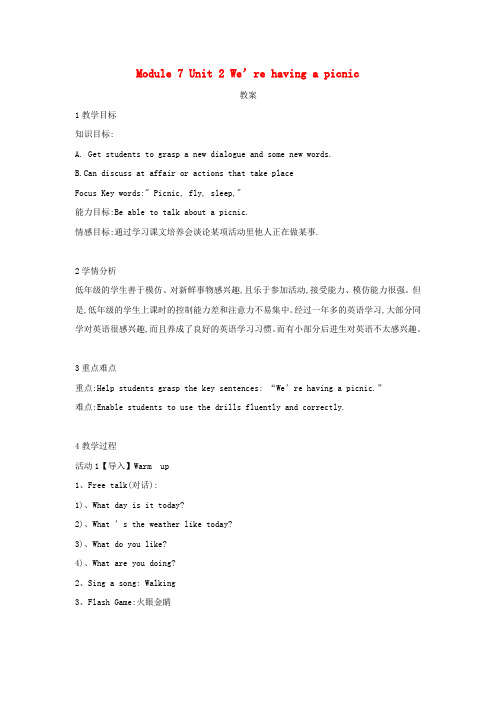
Module 7 Unit 2 We’re having a picnic教案1教学目标知识目标:A. Get students to grasp a new dialogue and some new words.B.Can discuss at affair or actions that take placeFocus Key words:" Picnic, fly, sleep,"能力目标:Be able to talk about a picnic.情感目标:通过学习课文培养会谈论某项活动里他人正在做某事.2学情分析低年级的学生善于模仿、对新鲜事物感兴趣,且乐于参加活动,接受能力、模仿能力很强。
但是,低年级的学生上课时的控制能力差和注意力不易集中。
经过一年多的英语学习,大部分同学对英语很感兴趣,而且养成了良好的英语学习习惯。
而有小部分后进生对英语不太感兴趣。
3重点难点重点:Help students grasp the key sentences: “We’re having a picnic.”难点:Enable students to use the drills fluently and correctly.4教学过程活动1【导入】Warm up1、Free talk(对话):1)、What day is it today?2)、What ’s the weather like today?3)、What do you like?4)、What are you doing?2、Sing a song: Walking3、Flash Game:火眼金睛活动2【讲授】PresentationIt’s a fine day. Ting ting’s family is having a picnic. Let’s have a look. Watch and listenListen and repeatLearn the sentence “I'm drawing a picture .”小组读,开火车读,边读边做动作。
外研版小学英语(一年级起点)二年级下册Module7 Unit2 参考教案

Unit2 参考教案We’re having a picnic.Teaching aims: Review the new words in Unit1; learn to sing the new song in part3. Teaching courses(教学过程)1. Warm up:Teacher: Hello, boys and girls. How are you? I’m very well. Thank you. Sit down please. What’s the weather like? I’m happy to have this lesson with you. Are you happy? Ok. Now let’s sing a song in Module2 Unit2.(Stand up).Sing a song: “I’m listening to music….”(actions)2. Revision:Before the new lesson, let’s look at the big screen.1) Show the words: do-doing………..Who can read it? (The Students read it.)2) Teacher: You did a good job, I made the words in different colours, green, blue and black. Do you know why? What’s the difference?......3) Teacher: Yes, do-doing, run-running, write-writing.4) Now let’s make sentences with these words? (Look at the big screen)(Do it one by one.)---What are you doing?---I’m….---What’s he/she doing?---He’s/She’s ….3. New lesson:1) Teacher: Please look at this picture.(put the pictures on the blackboard. This is Tingting’s family, Where’s Tingting? oh yes, this is Tingting, this is father, mother and grandma. They’re having a picnic.(show the words card)picnic means th ey’re eating, drinking and playing in a beautiful place.Read the words(read in pairs)And father is flying a kite; (read and do the actions);mother is eating; grandma is sleeping(read in a low or high voice)2) Teacher: Now open your books, listen and point, then answer some questions.Students: Read and discuss in pair then answer(Show the questions on the screen.)3) Read after the teacher. Teacher Circles the verbs with –ing.4. Practice:Look at your papers and do it.(write by themselves and then report)5. Homework:Listen to the tape and recite the text.6. Summary:All of the students are very interested in this unit, Most of them can master the materials, they can use the verbs with –ing freely. A few of the students just can read and understand it, but not master it. I’d like to give them chance to practice more.7. Personalized Design:(个性化设计)Read and choose.It’s Children’s Day today. Children are in the zoo. Look at the animals .Lions are eating. Monkeys are playing basketball. Elephants are walking. Giraffes are sleeping. Snakes are looking at the children. Teacher is talking to the children.1) What are the lions doing? They’re______________.2) What are the monkeys doing? They’re_________basketball.3) What are the snakes doing? They’re_________at the children.4) What are the elephants doing? They’re__________.5) What are the giraffes doing? They’re____________.。
- 1、下载文档前请自行甄别文档内容的完整性,平台不提供额外的编辑、内容补充、找答案等附加服务。
- 2、"仅部分预览"的文档,不可在线预览部分如存在完整性等问题,可反馈申请退款(可完整预览的文档不适用该条件!)。
- 3、如文档侵犯您的权益,请联系客服反馈,我们会尽快为您处理(人工客服工作时间:9:00-18:30)。
外研版(一起)二年级英语下册教案
Module 7
Unit 2 We're having a picnic.
教学目标
(一)知识技能目标:
能正确地听、说下列句型:
We’re having a picnic.
My father is flying a kite.
(二)运用能力目标:
1.要求学生能描述正在进行的活动。
2.能够熟练说唱本单元的童谣歌曲。
(三)素质教育目标:
让学生感受英语课堂的活跃性,让学生在日常生活中能运用所学语言。
教学重点
熟练掌握下列句子:
We’re having a picnic.
My father is flying a kite.
教学难点
1.具体描述图片中进行的不同活动,扩大语言的交际面。
2.熟练掌握本单元的重点句子。
教学意图
1.增加已学知识的复现率,培养学生对重点词汇和句子的认读能力。
2.通过多种形式的活动激发学生的学习兴趣。
3.培养学生的自主学习能力。
教具准备
1.教材相配套的教学录音带。
2.教学挂图。
3.一些小奖品。
教学过程
Step 1 Warming-up
1.教师热情地和学生打招呼,师生或学生之间互相问好。
教师询问学生:“What do you usually do at the weekend?”学生回答:“I usually go shopping.”教师接着问:“What are you doing now? ”引导学生回答:“I am learning English.”
2.全班合唱第二模块的歌曲《I am listening to music.》
(设计说明:上课伊始,教师向学生做简单的英语问候,消除了学生的紧张情绪,一首英语歌曲,自然过渡到了现在进行时的表达法。
)
Step 2 Presentation
1.T:同学们一定都喜欢到大自然中去野餐吧!
S:喜欢!
T:(老师取出一张课前准备好的照片)同学们,这是我与朋友参加聚会时的照片,然后告诉同学们:“I am in the party with my friends. I am saying a joke. Tom is drawing a picture. Susan is dancing .We are very happy.”教师可以提出问题:“What is Tom doing?”如果学生回答不出来,教师可以用中文进行解释。
这时教师说:“今天是个风和日丽的好日子,Tingting 一家人去公园野餐,我们一起去看看,体验他们的快乐吧!”
(设计说明:这种源于真实生活的话题引起了学生的共鸣,激发了学生强烈的求知欲,很自然地把学生引进了课文的学习中。
)
2.教师把本单元的教学挂图挂出来呈现给学生,让学生一边看图,一边仔细听录音。
听完一遍后,教师可以让同学们复述他们听到的单词或者句子。
3.教师再放录音,请学生打开书,学生边听边看书,同时用笔勾画出课文中的生词和词组,然后小组合作根据前后文,猜猜每个生词和词组的意思,解决问题。
教师可以把生词和词组写在黑板上,教师对这些生词和词组进行解释,帮助学生理解。
同时教师还可以鼓励认识这些生词和词组的学生当小老师来教全班学生,必要时可以辅以中文。
教师为学生示范每个单词的发音,并要求学生一起跟读。
注意纠正学生的发音,必要时辅以夸张的口型或放慢语速给学生做示范。
请学生模仿跟读,可以采取多种方式进行练习。
个别抽读,了解学生的掌握情况,及时矫正学生的语音语调。
(设计说明:教师让学生在听的过程中画出不懂的单词和词组,然后先让同学们通过小组合作解决问题。
这种探究式的学习方式,不仅提高了学生学习的趣味和效率,也为学生搭建了自主学习的平台。
)
3.教师再放录音,每句话后停顿,请学生跟读,模仿录音中的语音、语调,教师注意纠正学生的错误发音。
(设计说明:跟录音朗读有助于学生模仿地道的语音和语调,也能为学生学好英语打下基础。
)Step 3 Practice
1.教师把全班同学分成四组,分别代表Tingting, father, mother, grandma
2.老师放录音,小组的成员当听到描述的是自己所代表的人物时,就需要站起来。
例如:
Tape: My name is Tingting.
Tingting Group:(stand up and sits down)
Tape: My father is flying a kite.
Father Group:(stand up and then sits down)
…
3.教师再放一遍录音,当听到描述的是自己所代表的人物时,学生需要站起来,并做出相应的动作,展示出所指人物正在进行的动作。
看看哪个小组的同学动作最统一,准确率最高。
4.教师让学生看课本28页活动2 ,让学生带着问题听录音,争取找到正确的答案。
教师将人物名称写在黑板上,当学生听完录音之后,教师说出一个文中的人物,学生则需说出这个人正在进行的动作。
例如:
T:Mother
S:She is eating.
T:Father
S:He is flying a kite.
教师要注意学生人称“He”“She”的使用,对于学生出现的错误及时纠正。
(设计说明:活动1的录音已经放了很多遍了,学生应该对其掌握得差不多了,所以这个练习的设计让学生进一步巩固了本单元的重点内容。
)
Step 4 Learn to the song
1.同学们,属于你们的节日来到了,大家一定很开心,让我们怀着这份喜悦来学习今天这首悦耳动听的《Children’s Day》吧!
2.教师放录音,让学生听歌曲,从整体上把握歌曲大意。
逐行讲解,让学生明白意思。
在学生能够读出歌词时,再放录音,一句一顿,以便学生模仿。
3.教师再放录音,让学生跟着音乐边唱边表演。
此时还可以鼓励学生改编歌词,把歌曲中的
“Children’s Day”改成自己喜欢的节日,然后唱给大家听。
4.在班级组织一次“超级男生”和“超级女生”演唱。
让学生自由演唱或者小组成员组成合唱团的形式来演唱,最后评出“超级男生”和“超级女生”,教师给予奖励。
Step 5 Activity
教师把本单元活动4的图片分成几部分,贴在教室的各个角落,然后教师说出一种小动物的名称,一位同学就要找到它,然后对这幅图片进行描述。
Step 6 Summary
教师和学生一起归纳本单元所学的语言项目,或者让学生自行归纳整理,制作复习小报。
(设计说明:可以让学生自己整理归纳所学内容,培养学生的自主学习能力。
)
Step 7 Homework
1.把今天学的英语童谣唱给自己的爸爸妈妈听。
2.听今天的课文录音。
